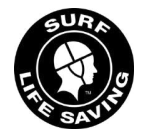(a) The decision to proceed to sea is ultimately the responsibility of the driver and crewperson.
(b) After entering the IRB the driver and crewperson must maintain their “normal position” as described below. This must be done in a safe manner with three secure points of contact maintained at all times.
(c) The normal driver position is defined as either foot in the foot strap, left hand holding the driver pontoon handle, right hand holding motor throttle grip, and seated on the pontoon.
(d) The normal crewperson position is the left foot in the foot strap, left hand holding the bow rope or handle, right hand holding the inner pontoon (boarding) handle or lifeline rope, and seated on the pontoon.
(e) The normal patient position is defined as positioned inside the IRB and holding onto the pontoon lifeline rope with at least one hand. The patient must not be seated on the floor or pontoon of the IRB.
Note: While not a disqualification point, patients are not encouraged to sit on the floor of the IRB.
(f) The only exceptions to these normal positions are detailed below and must be done so in a safe manner whilst maintaining three secure points of contact at all times.
(i) The crewperson and/or driver may leave their normal position to drag the IRB over a sand bar if the motor is electrically dead, or in the neutral position if left running.
(ii) The crewperson may rise from the seated position to absorb the impact of negotiating a wave or swell.
(iii) The crewperson may move into other crewing positions as described in the current edition of the SLSA IRB Training Manual when heading to sea and when necessary, including, but not limited to, punching a wave.
Note: A shift from the respective normal position of the driver, crew, or patient(s) is permitted provided that the team member does not otherwise become dislodged from their correct position.
(g) The driver and crewperson must maintain control of the IRB at all times during the competition to ensure it moves in a safe and controlled manner.
(h) The leading IRB, whilst proceeding to and from the buoys, shall, in the normal course, have right-of-way and the trailing IRB must take evasive action by turning or giving way to prevent collision.
Note 1: If at any time the leading boat’s driver considers that there is a risk of collision with the trailing boat, then the leading craft should take all measures necessary to avoid a collision, but in terms of competition adjudication the trailing IRB remains responsible for giving way to the leading craft.
Note 2: The standard avoidance measure, when on a direct collision course, is to steer right and pass safely to the port (left) side.

